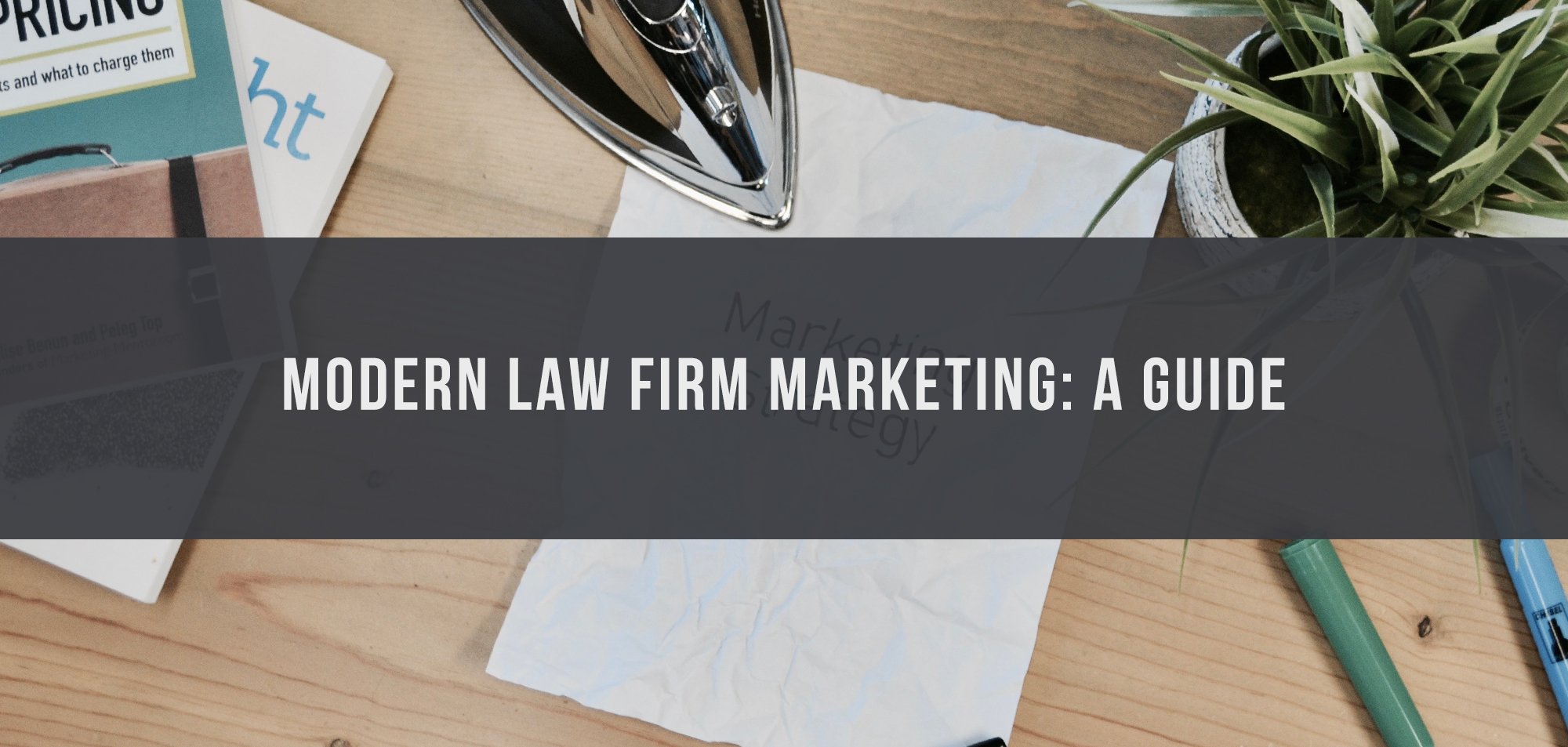
Audio Reading and Story highlights:
A law firm marketing tweet recently made the rounds. Went “viral,” really. It’s a video recording of cows crossing a road while making a special effort to avoid the middle line.

It’s funny, adorable, and totally relatable.
Okay, not technically a legal marketing tweet, but I could still see a lesson in there. As a solo attorney, I often felt it was easiest to avoid marketing-related ethical violations by just being boring.
Do things old school and the old guard will stay off my back. Avoid the white lines, even if it hurts my firm.
In time, though, I learned a few truths:
In this guide, we’ll walk through activities that will make your firm stand out to prospective clients. They’ll care about you because they’ll see that you care about them.
And since this is a “modern” legal marketing guide, let’s start with your website…
Here’s a twist: Your website is not the most important part of your marketing, and it’ll yield some of the slowest results. You should do it anyway.
[bctt tweet=”Your website is not the most important part of your marketing, and it’ll yield some of the slowest results. You should do it anyway.”]Crafting a good website – like all writing – forces you to think through big ideas. It’s true that clients won’t believe you exist unless you exist on the Web, but designing a website that serves its readers will help you in unexpected ways.
A good website is a sign of a thoughtful approach to attracting clients, so that’s where we’ll begin.
One of the better books I’ve read on client-centered marketing is Donald Miller’s Building a Story Brand. In it, Miller argues clearly and energetically that your website is not about you.
More specifically, Miller says that your website should guide visitors through a journey. Using the “hero’s journey” framework made famous by Joseph Campbell, Miller analogizes to prototypical hero stories like Star Wars, The Hunger Games, and the Harry Potter series to illustrate your prospective client’s journey.
Miller says that you can capitalize on that universal path by positioning yourself as the “old guide” character, the Obi Wan that leads Luke Skywalker to his personal victory. When you cast your prospect as the central hero, and you as the enabling guide, you make yourself indispensable.
For more on Story Brand and how the hero’s journey should inform your website design, watch this interview with Marshall Lichty:
Once you understand the principles behind client-centered website design, dig into these practical steps to improve your website’s performance and usability.
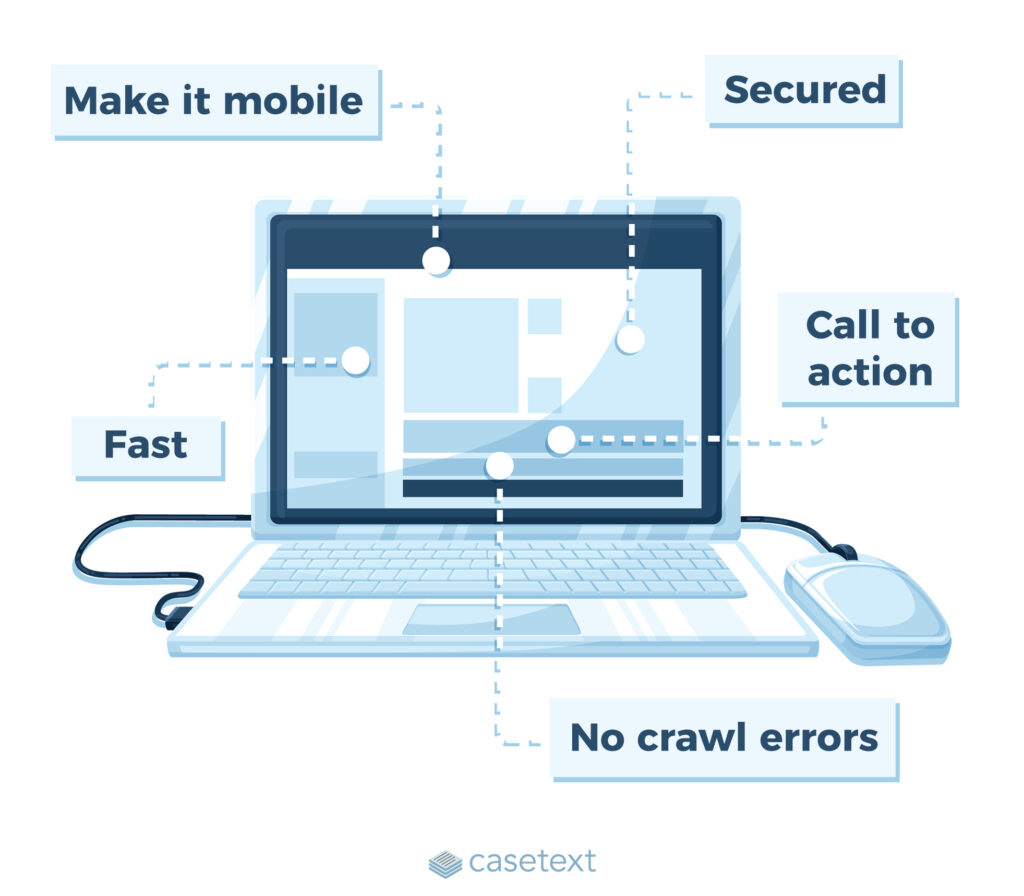
By now it’s common knowledge that Google likes mobile-friendly websites. Search engines like Google will actually punish your site in search results if it finds that it doesn’t adjust on mobile devices.
On one level, this is easy to fix. Most website themes adjust automatically to cell phones. On another level, focusing on mobile should inform strategic choices.
Is it clear what you want prospects to do once they land on your site? Does your scheduling system look good on a phone? How about your payments system? A truly mobile-friendly encompasses more than whether they have to pinch the screen to read it.
Without getting into the weeds on SSL certificates, let me ask you a question: Do you feel comfortable sharing your credit card with every random site on the internet? Obviously not. There are sites you trust, and some you don’t. You should do everything you can to have your website in the former camp.
Particularly if your firm takes online payments (and it should), you’ll want to secure your site. It’s not a difficult process, so either ask your webmaster to do this or follow these simple instructions to do it yourself.
According to CrazyEgg, a 1-second delay in a page’s load time results in a 7% loss in conversions, a 16% decrease in customer satisfaction, and 11% fewer page views. A slow website fails to make your prospective client feel like the hero of your law firm marketing story.
Google also penalizes slow sites, so if you want your law firm to appear in search results, follow this thorough guide to increase site speed.
Okay, this starts getting into the nerd-zone, so let’s keep it on the surface. In brief, you want Google’s robots to easily find their way around your site. All kinds of barriers can get in the way of that, and you need to eliminate those barriers.
In general, if you check your old content to make sure links are okay, you should be fine. Once you tell Google to index your site (meaning, send the robots your way), make sure to stay on top of your crawl errors. Make the robots happy.
A bit less technical but incredibly important, make sure your website’s readers know what you want them to do next. Do you want a phone call? Maybe an exchange for an email? To book a consultation online? Whatever you want prospects to do, make it clear.
There are several law firm marketing best practices you can implement to improve your site’s conversion rate (the percentage of people who actually do the thing you want them to do). In general, use clear and commanding language, make your buttons and text easy to distinguish from the rest of the site, and entice the reader with something nice.
Each of these website improvements will help prospective clients find and appreciate you. Keep their experience top of mind and you’ll get the results.
As I said earlier, if you want prospective clients to care about you then you have to first show that you care about them through your law firm marketing. Content is how you’ll do that.
In our post called The Lawyer’s Guide to Effective Referral Marketing, I wrote this:
When you openly publish your views and beliefs (marketing work with fewer ethics-related blockages), your Tribe will gather around you. Your Pub People will then step in, turning interested Tribe members into paying Fans.
You’d have to read that post for the full context, but the point is that content’s purpose is to attract like-minded people to your work. When you broadcast your views, they find you. But you can make that easy with a few easy practices that we’ll cover in this section.
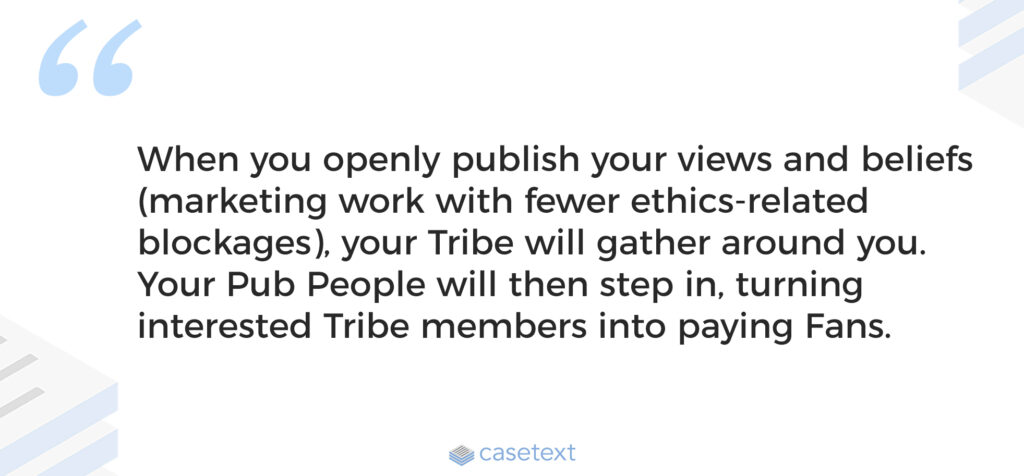
By being yourself loudly, you’ll attract interest. How you handle that interest sets your firm up for continued engagement, including opportunities to delight paying customers. That is the essence of Inbound Marketing, an idea created and mastered by the founder of marketing company Hubspot.
Let’s talk about the tactics you can employ for each of the three stages of successful Inbound Marketing:
First, you’ll want to identify what medium you’ll use to attract attention. In the early years, Content Marketing Institute founder Joe Pulizzi believes you should focus on just one medium, waiting to expand until later. This could include blogging, podcasting, video marketing, live events, and many more. Just find your favorite way to broadcast.
Once you bring people into your universe, define how you’ll stay connected. You may use gated opt-in content to collect email-addresses and do perpetual marketing via email, or you may use tools like bots or lead pages to other content. The goal is to keep interested readers interested, so define your means of staying top of mind.
Finally, define how you’ll reward those who engage with you over time. What kind of experience can you give that makes them feel like they’re part of your team? You could use private membership groups or subscriptions, but make sure you deliver more than a prospective client might expect. Plenty of lawyers want their business; what will you do to wow them?
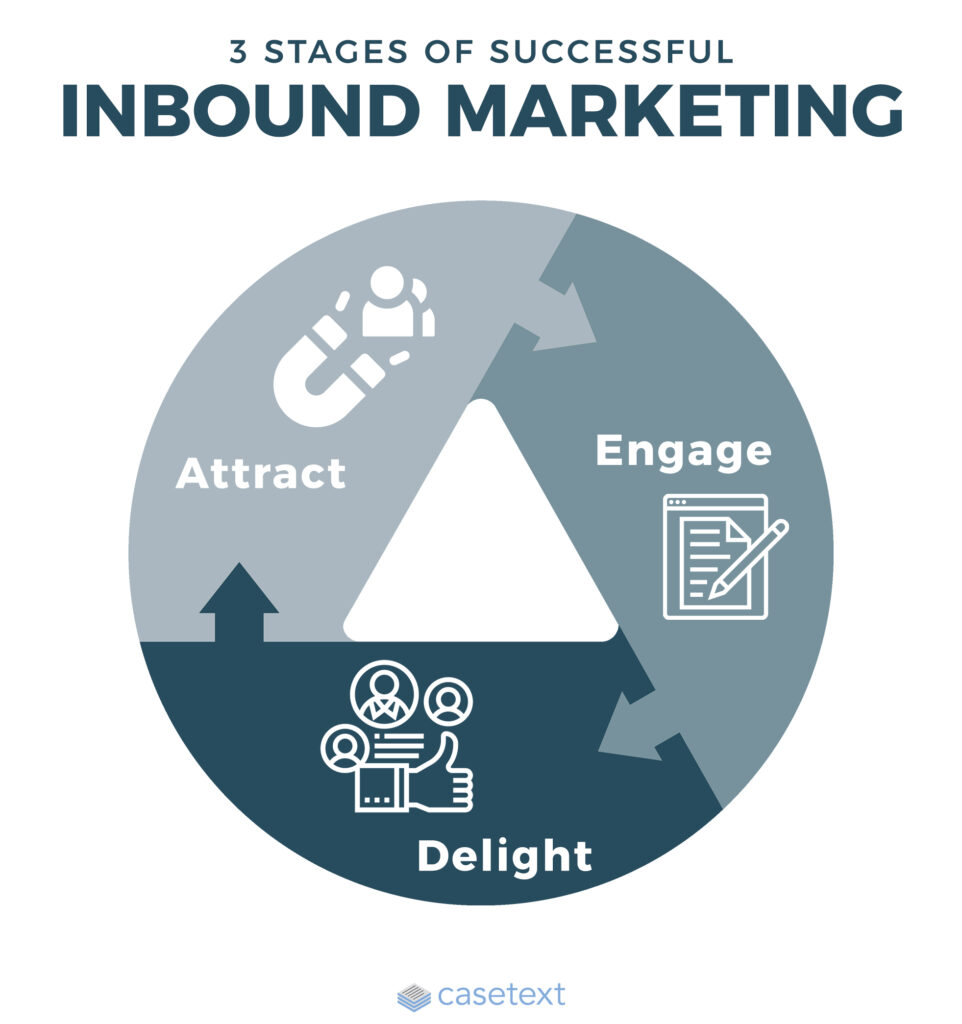
This 3-part process occurs over and over again throughout the client’s buyer cycle. Everything you do – from bringing prospects in, to serving clients, to following up after a case – should follow this process. It is a flywheel that keeps your business humming.
Not all content is created equal. I’d hate to push you to one medium over another, but keep in mind that Google loves words. They’re adding the ability to index podcasts very soon, and they like to promote videos, but the robots really prefer words.
The easiest way to make the robots happy is to start a blog. We’ll talk about ways to optimize that blog later in this post, but Google looks for websites that provide answers. They care about a searcher’s intent. If they want legal answers, give them to them. The Google robots will favor you.
Right behind words, Google likes videos. They even have a page dedicated to video best practices here.
Because Google places video results so high in a search return page, you may want to focus on videos in your law firm marketing. Opinions abound on the best subject and length for these videos, but make sure you don’t inflate your expectations. You won’t be Tom Cruise filmed by a team of professionals on day one.
Instead, start with these simple video ideas.
One strategy that lawyers often misunderstand is guest posting. Google has sent some signals that this approach is dead, and you should take a minute to understand why.
If you’re guest posting for Google, you’re doing it all wrong. Yes, those other sites will link back to you, but the volume of links is so low that it won’t really have an impact on your Google results. Instead, use guest posting to borrow the trust of someone else’s audience.
For example, let’s say you’re asked to write something for the local Chamber of Commerce website. You might do that if you believe that the Chamber’s readers are worth reaching; you shouldn’t do it to impress Google. Content, in this instance, is meant to borrow trust rather than build it, so keep an eye on that.
Similarly, social media activity is a way to borrow audience. Twitter, Facebook, LinkedIn… they’ve all spent years building up audience and capturing attention. Attention is the product they sell, and they want you to write for them so they’ll get it.
If you want to build an asset that you own, start by viewing social media as a distribution channel rather than an audience asset. Your Twitter followers are not yours, and neither are your LinkedIn connections. But, for a while, you can capture the attention of those audiences. If you’ll move them to your owned website, doing some of the opt-in steps we mentioned before, you’ll take advantage of the platforms’ enormous audiences.
Finally, recognizing that content’s purpose is to attract an audience, take a look at how you might pay for that attention. It may be worth it.
There are lots of ways to pay for attention online. Twitter ads, Facebook ads, YouTube ads, Adwords ads… In every case, the platform gathers an audience and you pay to access it. This is how you get beyond referrals and into a scalable firm.
To succeed at paid attention, Gary Vaynerchuk says you should think like a day trader. Rather than simply paying for eyeballs on a media platform you like, find ways to get the most out of a given dollar. You can spend anywhere and get something back. Ad buys are never a choice between good and evil; they’re a choice between good and better. Check out this article to get modern ideas on spending your ad dollar wisely.
The hardest part of these marketing efforts is determining whether they work. Because really, everything “works.” Every effort makes some kind of money. Making profits, however, requires more strategic thinking.
So, what should you measure? That depends on your strategy.
Marketing is full of vanity metrics. We get excited about things like follower counts and the number of attendees at a seminar, but those totals only matter if they’re consistent with your goals.
Before deciding what to measure, pick one result you want to optimize for. Is it traffic? Conversions to an email list? Conversions to sales? You’ll want to work on these things one at a time.
Take a look at this list of possible metrics based on goals from the Content Marketing Institute blog…
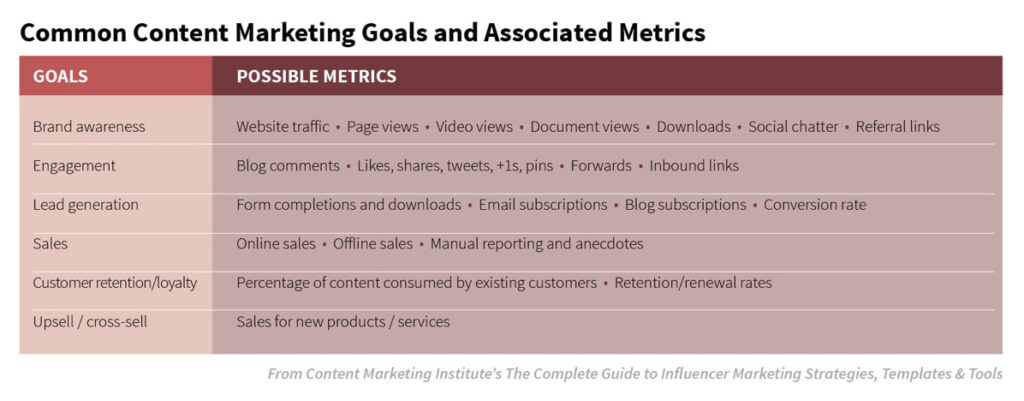
That’s a long list. Although you eventually want to meet every goal on this table, start by picking just one. Then choose a metric that you think is a leading indicator for that goal. That’ll be your “one thing” for a while. When you master that metric, you can add another, but not until then.
To determine which metric you’ll focus on first, put your marketing funnel on a white board. Here’s a generic version…
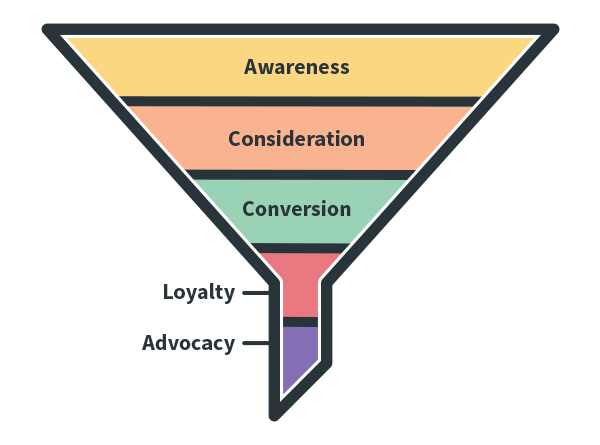
Now, write down your current strategy for each section of the funnel. List the stuff that you’re doing well, knowing that you’ll improve it later. Then take a look at what’s missing. The top-most stage with no strategy should be your first focus.
Once you’ve identified your first focus, pick a strategy and metric from the table above. That’s your One Thing. Use the tactics in this post and others to improve that One Thing, and measure results.
After you have measurements from different activities, you can evaluate them. What worked? What didn’t?
Remember, your definition of “worked” here is dependent upon the goal you measured for. Did your effort lead to 100s of clients? Unless you were working on the Conversion stage, that doesn’t matter. You’ll get to Conversions later. Focus on the one measurement you began with.
That said, you may have discovered a result you didn’t expect. For example, if you started a podcast in hopes of boosting traffic but noticed it’s actually a tool for developing referral sources (the “Advocacy” piece of the funnel), that’s good news. Keep doing that activity until you improve the Advocacy stage later, but know that you need a different tactic for the Awareness stage.
This will take time. Lots of time and effort. If you spend a whole year working on one stage of your funnel, you will not have wasted a moment. A winning funnel is an asset.
[bctt tweet=”This will take time. Lots of time and effort. If you spend a whole year working on one stage of your funnel, you will not have wasted a moment. A winning funnel is an asset.”]As you build each stage of your marketing funnel, please be sure to check in with your users. What’s their experience? You can’t fix everything they complain about today – they may even comment on a funnel section you’re not focused on yet – but put it down anyway. Tracking feedback is a good habit to get into, even if you can’t fix it all right now.
It’s tempting to digitize every social interaction because you think that scales. You want to believe that putting some money into ads or writing a weekly blog post will prompt the internet riches.
Intuitively, you know that’s not true. That’s why you see so many lawyers’ websites with a blog that hasn’t been updated in years. They gave the internet law firm marketing thing a try and the cash failed to rain down.
But those law firms didn’t die. Why? Because they kept doing the “old school” work. They followed Paul Graham’s famous advice to Do Things That Don’t Scale.
In this section, we’ll talk about the unscalable activities that you need to undertake in a scaled way.
Build relationships, one at a time, at a quick pace. Easy, right?
One unscalable activity you can do at scale is referral marketing. We covered this method in detail elsewhere on the blog, but let me summarize a few key points:
Another old school way to foster authority in your area is to write for bar publications and legal journals. That’s fallen off as a way to do attorney marketing, but that could make for a great opportunity.
Here’s an interview with Benjamin Wright about how to create and leverage quality articles for bar publications.
You can also gain exposure and trust by focusing on a public relations strategy. While most lawyers have pulled away from P.R. as a useful tactic, you can zig while they zag.
Check out the work of attorney Wayne Pollock on this. He has built an impressive advice library on YouTube. Wayne encourages lawyers to win in the “court of public opinion” by mastering communications with media. He’s a useful resource.
Finally, consider sending physical newsletters to referral sources, prospects, and former clients.
I know, I know. No one opens what you send in the mail. But the fact that you believe that may actually represent an opportunity. Because everybody believes that, and if everyone else has pulled away from direct mail advertising, you might actually find some cheap attention. (Back to the day trading analogy from above.)
Digital newsletters have fallen out of favor, but what can you send in the mail that will be worth engaging with?

One quick point before we end this conversation about marketing: everything seems to work when prospective clients sign engagement letters.
Remember that the end goal of any law firm marketing effort is to find profitable work from clients who respect you. Yes, you should pay attention to the entire value chain of someone’s experience with your firm, but closing deals solves a lot of nagging problems.
Here are a few things you can do to improve your sales rates:
One place to begin improving your interest-to-sales pipeline is in your initial phone calls.
Early in my career I heard several times from prospects, “I’m so impressed that you answer your own phone,” but the data didn’t support that effort. My ability to bring in new clients actually improved when I passed phone calls off to focused professionals.
Check out the Smith.ai blog for advice on outsourcing calls and using that to improve your close rates with prospective clients.
I really don’t want to get into the “lawyers are in sales” debate. Call it whatever you want, but you know that you’ve gotten better at consultations as your career has progressed.
Why? Because you’ve improved your understanding of a prospect’s needs and better aligned your offer to serve those needs. If you want to continue to improve your performance in consultations, be deliberate about recognizing client needs and the messaging around your offering.
To Sell is Human, after all.
Finally, I’d encourage you to look across your firm’s engagements with the human beings who interact with it. Are you making them feel appreciated?
A culture of service can cover up a lot of problems with your marketing and sales processes. Think of your social circles rather than your closed deals – are you making everyone feel important?
The more you improve that culture, the more others will want to see you succeed. They’ll support you, refer you, buy from you, and thank you. As you show that genuine care to your community, you will find marketing and sales success.

Rapidly draft common legal letters and emails.
How this skill works
Specify the recipient, topic, and tone of the correspondence you want.
CoCounsel will produce a draft.
Chat back and forth with CoCounsel to edit the draft.
Get answers to your research questions, with explanations and supporting sources.
How this skill works
Enter a question or issue, along with relevant facts such as jurisdiction, area of law, etc.
CoCounsel will retrieve relevant legal resources and provide an answer with explanation and supporting sources.
Behind the scenes, Conduct Research generates multiple queries using keyword search, terms and connectors, boolean, and Parallel Search to identify the on-point case law, statutes, and regulations, reads and analyzes the search results, and outputs a summary of its findings (i.e. an answer to the question), along with the supporting sources and applicable excerpts.
Get answers to your research questions, with explanations and supporting sources.
How this skill works
Enter a question or issue, along with relevant facts such as jurisdiction, area of law, etc.
CoCounsel will retrieve relevant legal resources and provide an answer with explanation and supporting sources.
Behind the scenes, Conduct Research generates multiple queries using keyword search, terms and connectors, boolean, and Parallel Search to identify the on-point case law, statutes, and regulations, reads and analyzes the search results, and outputs a summary of its findings (i.e. an answer to the question), along with the supporting sources and applicable excerpts.
Get a thorough deposition outline in no time, just by describing the deponent and what’s at issue.
How this skill works
Describe the deponent and what’s at issue in the case, and CoCounsel identifies multiple highly relevant topics to address in the deposition and drafts questions for each topic.
Refine topics by including specific areas of interest and get a thorough deposition outline.
Ask questions of contracts that are analyzed in a line-by-line review
How this skill works
Allows the user to upload a set of contracts and a set of questions
This skill will provide an answer to those questions for each contract, or, if the question is not relevant to the contract, provide that information as well
Upload up to 10 contracts at once
Ask up to 10 questions of each contract
Relevant results will hyperlink to identified passages in the corresponding contract
Get a list of all parts of a set of contracts that don’t comply with a set of policies.
How this skill works
Upload a set of contracts and then describe a policy or set of policies that the contracts should comply with, e.g. "contracts must contain a right to injunctive relief, not merely the right to seek injunctive relief."
CoCounsel will review your contracts and identify any contractual clauses relevant to the policy or policies you specified.
If there is any conflict between a contractual clause and a policy you described, CoCounsel will recommend a revised clause that complies with the relevant policy. It will also identify the risks presented by a clause that does not conform to the policy you described.
Get an overview of any document in straightforward, everyday language.
How this skill works
Upload a document–e.g. a legal memorandum, judicial opinion, or contract.
CoCounsel will summarize the document using everyday terminology.
Find all instances of relevant information in a database of documents.
How this skill works
Select a database and describe what you're looking for in detail, such as templates and precedents to use as a starting point for drafting documents, or specific clauses and provisions you'd like to include in new documents you're working on.
CoCounsel identifies and delivers every instance of what you're searching for, citing sources in the database for each instance.
Behind the scenes, CoCounsel generates multiple queries using keyword search, terms and connectors, boolean, and Parallel Search to identifiy the on-point passages from every document in the database, reads and analyzes the search results, and outputs a summary of its findings (i.e. an answer to the question), citing applicable excerpts in specific documents.
Get a list of all parts of a set of contracts that don’t comply with a set of policies.
Ask questions of contracts that are analyzed in a line-by-line review
Get a thorough deposition outline by describing the deponent and what’s at issue.
Get answers to your research questions, with explanations and supporting sources.